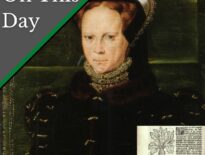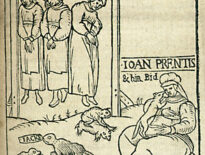On this day in Tudor history, 6th July 1553, fifteen-year-old King Edward VI died at Greenwich Palace.
His "devise for the succession" named his heir as Lady Jane Grey, the daughter of Edward's cousin, Frances Grey (née Brandon), Duchess of Suffolk.
In the video (or transcript) below, I give details of Edward's final illness and last days, his "Devise for the Succession", and Lady Jane Grey's reaction at being told that she was Edward's successor.
On this day in Tudor history, 6th July 1553, at Greenwich Palace, fifteen -year-old King Edward VI lay dying. He prayed:
“Lord God, deliver me out of this miserable and wretched life, and take me among thy chosen: howbeit not my will, but thy will be done. Lord I commit my spirit to thee. O Lord! Thou knowest how happy it were for me to be with thee: yet, for thy chosen’s sake, send me life and health, that I may truly serve thee. O my Lord God, bless thy people, and save thine inheritance! O Lord God save thy chosen people of England! O my Lord God. defend this realm from papistry, and maintain thy true religion; that I and my people may praise thy holy name, for thy Son Jesus Christ’s sake!”
Then, between 8 and 9 o'clock that evening, Edward died in the arms of Sir Henry Sidney, one of the Chief Gentleman of his Privy Chamber. His last words were reported to be "I am faint; Lord have mercy upon me, and take my spirit".
Edward VI had been ill for several months, his immunity having been affected by contracting smallpox and measles at the same time the previous year. By 20th May 1553, the Imperial Ambassador, was describing Edward’s condition as “desperate”, and on the 30th May he wrote:
“The King of England is wasting away daily, and there is no sign or likelihood of any improvement. Some are of opinion that he may last two months more, but he cannot possibly live beyond that time. He cannot rest except by means of medicines and external applications; and his body has begun to swell, especially his head and feet. His hair is to be shaved off and plasters are going to be put on his head. The illness is judged to be the same as that which killed the late Earl of Richmond.”
On 11th June, the imperial ambassador reported that “The King’s indisposition is becoming graver and graver”, and on 12th June the judges of the King’s Bench were shown the King’s Devise and ordered to turn it into a legal will. The judges refused, as they were worried that overturning the succession would be considered treason, but Edward explained the reasons behind his decision:
“For indeed my sister Mary was the daughter of the king by Katherine the Spaniard, who before she was married to my worthy father had been espoused to Arthur, my father’s elder brother, and was therefore for this reason alone divorced by my father. But it was the fate of Elizabeth, my other sister, to have Anne Boleyn for a mother; this woman was indeed not only cast off by my father because she was more inclined to couple with a number of courtiers rather than reverencing her husband, so mighty a king, but also paid the penalty with her head – a greater proof of her guilt. Thus in our judgement they will be undeservedly considered as being numbered among the heirs of the king our beloved father.”
He demanded that the judges should accept his wishes and legalise his “Devise”, and the judges were told that to refuse the King’s command would be seen as treason.
On 21st June 1553, Edward VI's "devise" was issued as "Letters Patent for the Limitation of the Crown",having been drawn up by Sir Edward Montague, Chief Justice of the Common Pleas, and John Gosnold, Solicitor General of the Court of Augmentations. In his devise, Edward VI stipulated that his crown was to be passed on to "the eldest SON OF THE BODY OF THE SAID LADY FRANCES [Frances Brandon, Duchess of Suffolk], LAWFULLY BEGOTTEN, being born into the world in our lifetime". But Frances did not have any sons, so when Edward’s health worsened, the king decided to change the Device to read: “To the Lady Frances’s heirs males, if she have any such issue before my death, to the Lady Jane and her heirs males.”
Edward removed his half-sisters from the line of succession, stating “[...] the said lady Marye as also the said ladie Elizabeth to all intents and purposes are and be clearly disabled to aske, claime, or challenge the said imperiall crowne, or any other of our honores, castelles, manores, lordeshipes, lands, tenements, and hereditaments as heire or heires to us or to any other person or persones who soevere, aswell for the cause before rehearsed, as also for that the said lady Mary and lady Elizabeth be unto us but of the halfe bloud, and therfore by the auntyent lawes, statutes, and customes of this realme be not inheritable unto us, although they were legitimate, as they be not indeed.”
He also passed over the Stuart line (Mary, Queen of Scots), as his father, Henry VIII, had done in his will.
On the 4th July, the imperial ambassador reported that Edward had appeared at a window at Greenwich some days before to prove to everyone that he was still alive, but that he was “so thin and wasted that all men said he was doomed”. The ambassador thought that he would not last much longer, and he didn’t.
When Edward died on this day in history, 6th July 1553, Frances did not have a son, so Jane became queen, being officially proclaimed Queen Jane on 10th July 1553.
Jane did not find out she was queen until 9th July 1553. When she was informed of Edward VI's death and the fact that the king had nominated her as his successor, Jane was said to have collapsed weeping and declared "The crown is not my right and pleases me not. The Lady Mary is the rightful heir." However, once the Duke of Northumberland and her parents had explained Edward's wishes to her, it appears that Jane then saw the crown as her duty and destiny. She later told Mary I:
"Declaring to them my insufficiency, I greatly bewailed myself for the death of so noble a prince, and at the same time, turned myself to God, humbly praying and beseeching him, that if what was given to me was rightly and lawfully mine, his divine Majesty would grant me such grace and spirit that I might govern it to his glory and service and to the advantage of this realm."
Her reign, though, was to be just thirteen days, for Edward's eldest half-sister, Mary, rallied support and was proclaimed queen on 19th July 1553. Lady Jane Grey, the former Queen Jane, was executed on 12th February 1554, following her father's involvement in Wyatt's Rebellion.



Leave a Reply